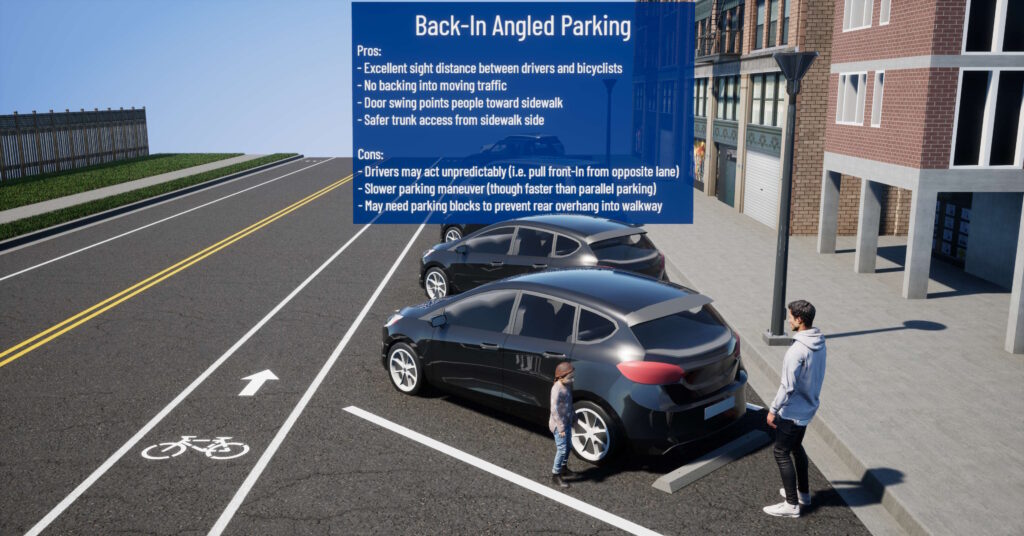Imagine this – you’ve already punched in the address in your navigation app and are driving to the new coffee shop downtown. As you get close, you realize they don’t have a parking lot; you’ll have to park on-street. Approaching the destination, you see the perfect spot. Right near the entrance, and plenty of room to pull in comfortably.
What’s your idea of the “perfect spot”? Are you picturing parallel parking with plenty of room in front and back? Is it front-in angled parking that’s quick and easy to pull into?
It’s probably not a back-in angled parking space, but it could be soon.
Introducing: Back-In Angled Parking
In recent years, back-in angled parking configurations have been gaining popularity in many cities. They provide a number of safety benefits that are not quickly apparent to most drivers.
This type of parking requires a maneuver that lies somewhere between head-in angled and parallel parking in terms of difficulty for a driver.
Similar to parallel parking, you would drive just past the parking space, stop, and put your car in reverse. With the help of mirrors and back-up cameras, it’s just one backwards turn to pull into the open space. It’s definitely easier than parallel parking (especially when people are watching).

Let’s go back to your coffee run. You’ve made your purchase and it’s time to head home. You start your car and check your surroundings to see if it’s all clear to pull out of the space. There’s quite a bit of traffic on the road, including some cyclists in the bike lane.
Is this still your perfect spot? Does it seem stressful waiting to find a large enough gap in the traffic to leave the space? Are you doing all of this by looking in mirrors where vehicles “may be closer than they appear”?


The obvious benefit from back-in angled parking lies here – getting back in traffic. Because the front end of the car faces the street, visibility is vastly improved – rearview mirrors not required. As a driver, you can clearly see oncoming traffic out your side window – both cars and bikes. You won’t need to stop in the lane of traffic to change directions.
There are plenty of other benefits, too – especially when compared to front-in parking. Need to get something out of your trunk? Better to do that closer to the sidewalk than the moving traffic. Picture opening a rear door and a child getting out from the back seat. With front-in parking, the door swing points them toward the road. A back-in configuration points them away from it.
At some point, it might start to sound like back-in angled parking is a no-brainer. It’s much safer, and easier to do than parallel parking, which most of us had to master before getting our license. Not so fast.
Unfamiliar, Uncertain, Unsafe
City planners and engineers will tell you that most of the drawbacks to back-in angled parking revolve around the fact that people just haven’t encountered them before. This can lead to unpredictable driving behavior, which in the transportation world is a big risk to roadway safety.
Unfamiliarity with new installations has already had plenty of unexpected results. If not properly marked, drivers will still pull head-in, taking up 2 or 3 back-in spaces. Some municipalities have parked and left city vehicles in an empty row of new back-in angled parking so other drivers can see that as a cue to park in a similar manner.
Even when marked, there are other concerns. Backing into a space often results in vehicles overhanging the sidewalk – blocking walkways or striking street furniture located behind the curb. Sometimes precast concrete curb stops are placed within the space to stop the wheels before getting close to the sidewalk. Sometimes motorists will even pull front-in by making a left turn from the opposite side of the road – an unpredictable and dangerous movement in its own right – making leaving that space even more difficult and dangerous.



All too often in street design, conventionality reigns supreme. Where driver behavior is predictable and expected, road safety can prevail (it’s why we have a Manual on Uniform Traffic Control Devices in the first place). These parking configuration decisions don’t come lightly – municipalities are frequently weighing the trade-offs that come with choosing convention or innovation.
In the case of back-in angled parking, however, overcoming its unfamiliarity can result in enhanced visibility, safer operations, and added convenience. In a pro and con list, most of the cons have to do with motorists not knowing how to use them. It seems like simply educating our drivers on what to expect when they see back-in angled spaces will tip the scales so that the safety benefits far outweigh the risks.
How will we get there? Having more people picture backing in to their perfect spot.
The visuals used in this article have been made with Beyond Typicals, a simple yet powerful drag-and-drop 3D typical section creator that empowers designers & planners to build road visualizations in minutes and edit in real time.
Click here to sign up for a free 30-day trial of Beyond Typicals (no credit card needed).

Brian Sroufe, P.E.
Brian is a licensed professional engineer with 15 years of urban transportation design and project management experience. As Beyond CAD's Business Development Manager, he now demonstrates the incredible value that easily-assembled 3D roadway visualizations built with Beyond Typicals can bring to communicating transportation safety and mobility improvements.

